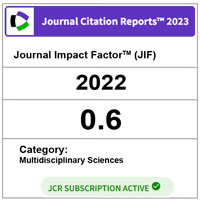Solar radiation forecast using hybrid SARIMA and ANN model
DOI:
https://doi.org/10.11113/mjfas.v13n4-1.895Keywords:
SARIMA, ANN, Hybrid Mode, Solar Radiation, ForecastingAbstract
Solar Energy have an enormous potential for generating renewable electricity. In the tropics solar energy are abundance all year long but suffer from uncertainty caused by rain and clouds. Accurate prediction of solar radiation can increase the affectivity and productivity of solar energy sources. Monthly average of solar radiation data are obtained from stations in Malaysia. The data are modeled using the Seasonal Autoregressive Integrated Moving Average (SARIMA) model, artificial neural network (ANN) model and Hybrid ANN and SARIMA model. The SARIMA model is a reliable tool in forecasting seasonal data, on the other hand the ANN model have been proven to be a good model in forecasting non-linear data. By combining both model a more accurate model can be obtained. Finally the forecasting performance each model is compared by using mean absolute error (MAE), the mean absolute percentage error (MAPE) and root mean square error (RMSE). The result shows that the hybrid model is better in forecasting solar radiation data.
References
Grantham, Adrian, Gel, Yulia R. and Boland, John. (2016). Nonparametric short-term probabilistic forecasting for solar radiation. Solar Energy. 133, 465–475
Jiang, He, Dong, Yao and Xiao, Ling. (2017). A multi-stage intelligent approach based on an ensemble of two-way interaction model for forecasting the global horizontal radiation of India. Energy Conversion and Management. 137, 142–154.
Monjoly, Stephanie, Andre, Maina, Calif, Rudy and Soubdhan, Ted. (2017). Hourly forecasting of global solar radiation based on multi scale decomposition methods: A hybrid
approach. Energy. 119, 288-298.
Jiménez-Pérez, Pedro F., Mora-López, Llanos. (2016). Modeling and forecasting hourly global solar radiation using clustering and classification techniques. Solar Energy. 135, 682–691.
Law, Edward W., Kay, Merlinde and Taylor, Robert A. (2016). Evaluating the benefits of using short-term direct normal irradiance forecasts to operate a concentrated solar thermal plant. Solar Energy. 140, 93–108.
Huang, Jing, Korolkiewicz, Małgorzata, Agrawal , Manju and Boland, John . (2013). Forecasting solar radiation on an hourly time scale using a Coupled AutoRegressive and Dynamical System (CARDS) model. Solar Energy. 87, 136–149.
Jha, Sunil Kr., Bilalovic, Jasmin, Jha, Anju, Patel, Nilesh, and Zhang, Han. (2017). Renewable energy: Present research and future scope of Artificial Intelligence. Renewable and Sustainable Energy Reviews. 77, 297–317.
Khashei, M. and Bijari, M. (2011). A novel hybridization of artificial neural networks and ARIMA models for time series forecasting. Appl. Soft Computing. 11,2664–2675.
Zhang, G.P. (2003). Time series forecasting using a hybrid ARIMA and neural network model. Neurocomputing. 50, 159–175.
Jeong, Kwangbok, Koo, Choongwan and Hong , Taehoon. (2003). An estimation model for determining the annual energy cost budget in educational facilities using SARIMA (seasonal autoregressive integrated moving average) and ANN (artificial neural network). Energy. 2014. 71, 71-79.
Wu, Ji and Chan, Chee Keong. (2011). Prediction of hourly solar radiation using a novel hybrid model of ARMA and TDNN. Solar Energy. 85, 808–817.
Dı´az-Robles, Luis A., Ortega, Juan C., Fu, Joshua S., Reed, Gregory D., Chowc, Judith C., Watson, John G. and Moncada-Herrera, Juan A. (2008). A hybrid ARIMA and artificial neural networks model to forecast particulate matter in urban areas: The case of Temuco, Chile. Atmospheric Environment. 42,8331–8340.
Kanel, Ibrahim Lawal, Yusof, Fadhilah. (2013) Assessment of Risk of Rainfall Events with a Hybrid of ARFIMA-GARCH. Modern Applied Science. 7, 78-89.
Fang, Tingting and Lahdelma, Risto. (2016). Evaluation of a multiple linear regression model and SARIMA model in forecasting heat demand for district heating system. Applied Energy. 179, 544–552.
Box, G.E.P. and Jenkins, G.M. (1976). Time Series Analysis: Forecasting and Control. San Francisco: Holden Day.
Bas, María del Carmen, Ortiz, Josefina, Ballesteros, Luisa and Martorell, Sebastian. (2017). Evaluation of a multiple linear regression model and SARIMA model in forecasting 7Be air concentrations. Chemosphere. 177, 326-333.
Dickey, D.A. and Fuller, W.A. (1981). Likelihood ratio statistics for autoregressive time series with a unit root. Econometrica. 49, 1057–1072.
Akaike, H. (1974). A new look at the statistical model identification. IEEE Transaction on Automatic Control. 19,716–723.
Ljung, G.M. and Box, G.E.P. (1978). On a measure of lack of fit in time series models. Biometrika. 65,279–303.
Haykin, Simon O. (2009). Neural Networks and Learning Machines. Ontario: Pearson.
Armstrong, J. Scott. (2002). Principles of Forecasting: A Handbook for Researchers and Practitioners New York: Kluwer Academic Publishers.







